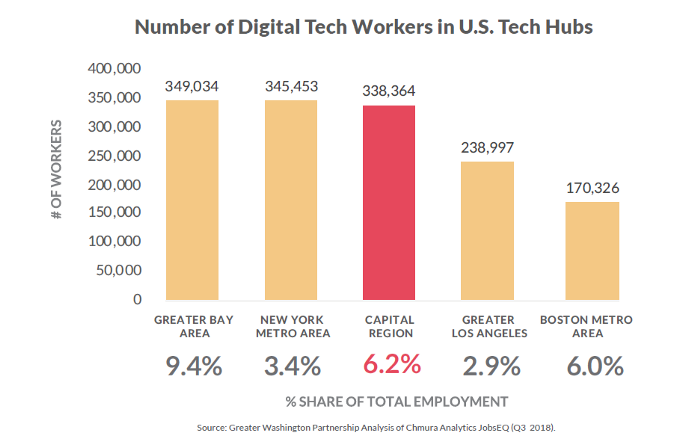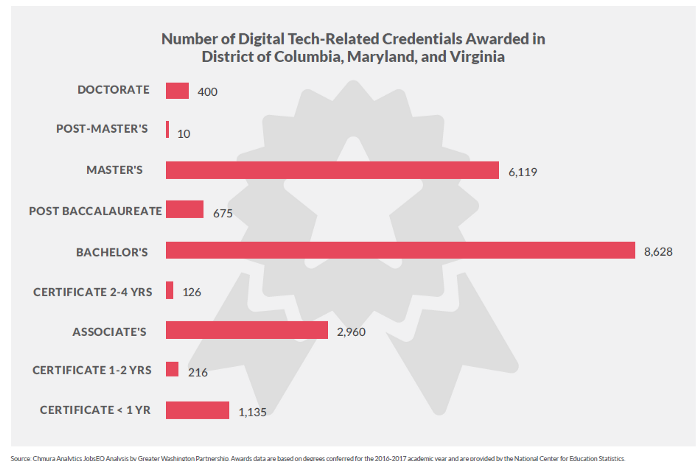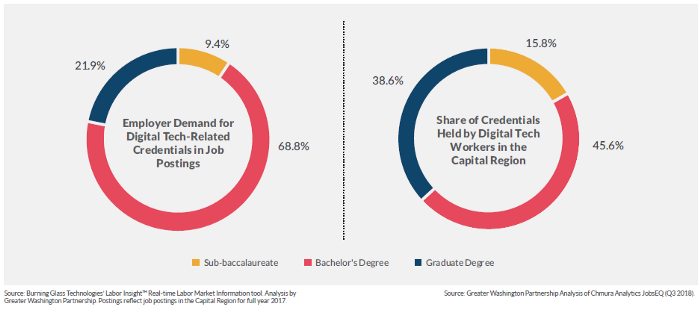In its search for a new headquarters, Amazon cited the importance of talent, talent, and more talent. And it ended up in Crystal City — at the center of the Capital Region, which spans from Baltimore to Richmond. Amazon’s choice is supported by regional labor market data and makes it clear that our region has much to offer. We are home to more than 338,000 digital tech workers in fields like cybersecurity, data science, software engineering, and computer programming — making our digital tech workforce the third largest in the country. Moreover, digital tech workers make up 6.2 percent of our workforce, second only to the Bay Area.

Our status as a tech giant is no accident. The more than 100 institutions of higher education in the region have worked diligently to ensure their graduates are ready for our growing tech presence, increasing their production of digital tech awards, including degrees and certificates, by 52 percent from 2010 to 2017. In 2017 alone, there were more than 20,000 digital tech-related awards granted by education providers in the District of Columbia, Maryland, and Virginia. More specifically, students in the Capital Region earned more digital tech bachelor’s degrees than in any other region in the United States. State governments and businesses are also investing in higher education to support their efforts to increase the number of students with the digital tech skills and to better connect innovation to the regional economy.

Our tremendous pool of talented, tech-savvy workers, along with a steady pipeline of digital tech graduates, helped attract Amazon to our region. To keep this momentum going and further grow our region’s status as a tech powerhouse, the Greater Washington Partnership is working with employers and educators to ensure that students graduate with the knowledge, skills, and abilities that are most in-demand in the Capital Region.
From Baltimore to Richmond, our region has never been more unified, and we are better positioned than ever to educate and grow our tech workforce — not only for large technology firms, but for all employers who drive our economy and make up our innovation ecosystem.
Retaining tech talent
Last year, colleges and universities in our region awarded thousands more digital tech degrees in majors such as, cybersecurity, data science, computer engineering, and computer science than in cities like San Francisco and Boston, commonly held up as centers of technological growth and innovation.

Amazon’s move to the Capital Region is expected to generate over 25,000 new jobs, with an average wage of over $150,000 and many within digital tech fields. While area colleges are doing their part to create the supply of relevant talent, we need to do a better job keeping these graduates in the area. The Greater Washington Partnership is working with educators and the business community to ensure that we produce high numbers of ambitious, skilled students, while improving the housing, infrastructure, and communities to keep them here. The Capital Region must grow, attract, and retain talent to diversify our economy and transform our region into an economic powerhouse.
Lift all boats!
In the Capital Region students who graduate with a digital tech degree can expect excellent employment prospects. The median wage in digital tech tops $100,000 a year, and we’re growing so quickly that employer demand far exceeds the supply of talent. Our region has more open positions in digital tech per capita than any of the other traditional “tech giants” — 1.5 times that of Boston and twice the rate of New York City. And with Amazon’s impending move to the region — and the 25,000 new jobs, at least, that the company will bring with it — this demand for tech talent will only grow.

However, our region’s status as a tech powerhouse has left some populations behind. Only 18 percent of our digital tech workforce is black, and 5 percent is Hispanic, even though those demographics make up 27 percent and 11 percent of our population, respectively. If not addressed, this tech talent divide will only exacerbate the income and opportunity inequalities in our region today.
The Greater Washington Partnership will play a key role in JP Morgan Chase’s New Skills for Youth Initiative, by creating a region-wide “Employer Signaling System” for collecting information on talent needs from employers, disseminating it to schools, and helping schools use the information to inform their pathway developments. This new investment will support five area school districts, working with community colleges and universities, to design educational pathways that connect students to high-demand careers in technology. This is a natural extension of the work the Partnership has been leading through the Capital CoLAB, an action-oriented partnership of the region’s top academic institutions and businesses to make the Capital Region a leading global hub for innovation.
In collaboration with educators and the business community, the Greater Washington Partnership is working to ensure that the entire region is able to benefit from our status as a tech hub. With the spirit of regional unity stronger than ever, we have never been better poised to build an inclusive, thriving, and unified region that works for everyone.
Read More: Tech Talent In The Capital Region
Authored by former Director of Workforce Initiatives, Jennifer Thornton
